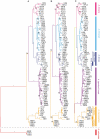An overlooked dispersal route of Cardueae (Asteraceae) from the Mediterranean to East Asia revealed by phylogenomic and biogeographical analyses of Atractylodes
- PMID: 35533344
- PMCID: PMC9295924
- DOI: 10.1093/aob/mcac059
An overlooked dispersal route of Cardueae (Asteraceae) from the Mediterranean to East Asia revealed by phylogenomic and biogeographical analyses of Atractylodes
Abstract
Background and aims: The East Asian-Tethyan disjunction pattern and its mechanisms of formation have long been of interest to researchers. Here, we studied the biogeographical history of Asteraceae tribe Cardueae, with a particular focus on the temperate East Asian genus Atractylodes DC., to understand the role of tectonic and climatic events in driving the diversification and disjunctions of the genus.
Methods: A total of 76 samples of Atractylodes from 36 locations were collected for RAD-sequencing. Three single nucleotide polymorphism (SNP) datasets based on different filtering strategies were used for phylogenetic analyses. Molecular dating and ancestral distribution reconstruction were performed using both chloroplast DNA sequences (127 Cardueae samples) and SNP (36 Atractylodes samples) datasets.
Key results: Six species of Atractylodes were well resolved as individually monophyletic, although some introgression was identified among accessions of A. chinensis, A. lancea and A. koreana. Dispersal of the subtribe Carlininae from the Mediterranean to East Asia occurred after divergence between Atractylodes and Carlina L. + Atractylis L. + Thevenotia DC. at ~31.57 Ma, resulting in an East Asian-Tethyan disjunction. Diversification of Atractylodes in East Asia mainly occurred from the Late Miocene to the Early Pleistocene.
Conclusions: Aridification of Asia and the closure of the Turgai Strait in the Late Oligocene promoted the dispersal of Cardueae from the Mediterranean to East China. Subsequent uplift of the Qinghai-Tibet Plateau as well as changes in Asian monsoon systems resulted in an East Asian-Tethyan disjunction between Atractylodes and Carlina + Atractylis + Thevenotia. In addition, Late Miocene to Quaternary climates and sea level fluctuations played major roles in the diversification of Atractylodes. Through this study of different taxonomic levels using genomic data, we have revealed an overlooked dispersal route between the Mediterranean and far East Asia (Japan/Korea) via Central Asia and East China.
Keywords: Atractylodes; Cardueae; East Asian–Tethyan disjunction; biogeography; phylogenomics.
© The Author(s) 2022. Published by Oxford University Press on behalf of the Annals of Botany Company. All rights reserved. For permissions, please e-mail: journals.permissions@oup.com.
Figures



References
-
- Ackerfield J, Susanna A, Funk V, et al. .. 2020. A prickly puzzle: Generic delimitations in the Carduus–Cirsium group (Compositae: Cardueae: Carduinae). Taxon 69: 715–738.
-
- Aitchison JC, Ali JR, Davis AM. 2007. When and where did India and Asia collide? Journal of Geophysical Research-Solid Earth 112: B05423.
-
- Anderberg AA, Ghahremaninejad F, Källersjö M. 2007. The enigmatic genus Dipterocome. Compositae Newsletter 45: 23–36.
-
- Axelrod DI. 1975. Evolution and biogeography of Madrean-Tethyan sclerophyll vegetation. Annals of the Missouri Botanical Garden 62: 280–334.
Publication types
MeSH terms
LinkOut - more resources
Full Text Sources

